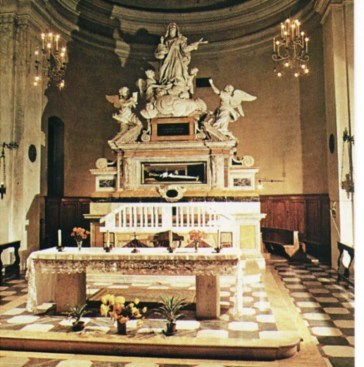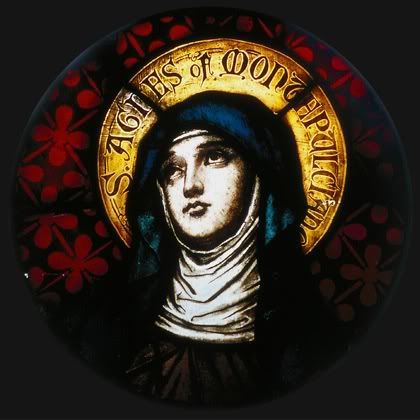#stagnesofmontepulciano
Text
Our Lady of Schier, Bavaria and Memorials of the Saints - 20 April
Feria DayThursday in the Second Week of Easter
Our Lady of Schier, Bavaria – 20 April:HERE:https://anastpaul.com/2021/04/20/our-lady-of-schier-bavaria-and-memorials-of-the-saints-20-april/
St Agnes of Montepulciano OP (1268-1317) Virgin, Sister and Abbess of the Order of Preachers, Mystic, known as “The Miracle Worker” – her body is incorrupt. Agnes was Beatified in 1534 and Canonised in 1726…

View On WordPress
#blhildegunofschonau#blsimonrinalducci#ourladyofschierbavaria#saints20april#stagnesofmontepulciano#stmarcellinusofembrun
2 notes
·
View notes
Text
Our Lady of Schier, Bavaria and Memorials of the Saints - 20 April
Our Lady of Schier, Bavaria and Memorials of the Saints – 20 April
uesday of the Third Week of Easter +2021
Our Lady of Schier, Bavaria – 20 April:
The Abbot Orsini wrote: “This Church was built on the spot where the castle stood, which those of the house of Scheir voluntarily ceded to Our Lady, except Arnaud, who, in punishment of his obstinacy, was accidentally drowned in a neighbouring lake.”
Arnaud Schier is remembered as being the odd son of the Bavarian…

View On WordPress
#blchiarabosatta#blsimonrinalducci#ourladyofschierbavaria#saints20april#stagnesofmontepulciano#stmarcellinus
4 notes
·
View notes
Video
youtube
Easter Vigil in the Holy Night and Memorials of the Saints – 20 April St Agnes of Montepulciano OP (1268-1317) About St Agnes: St Pope Anicetus (Died c 168)
3 notes
·
View notes
Photo




Saint of the Day – 20 April – St Agnes of Montepulciano O.P. (1268-1317) Religious Nun and Abbess “The Miracle Worker” – Attributes – Dominican Nun with a lily and a lamb. Her Body is incorrupt and her major Shrine is Church of St Agnes, Montepulicano, Siena, Italy.
St Agnes was born in 1268 into the noble Segni family in Gracciano, a frazione of Montepulciano – in Siena, Italy, then part of the Papal States. At the age of nine, she convinced her parents to allow her to enter a Franciscan monastery of women in the city known as the “Sisters of the Sack”, after the rough religious habit they wore. they live a simple, contemplative life. She received the permission of the pope to be accepted into this life at such a young age, normally against Church law.
In 1281, the lord of the castle of Proceno, a fief of Orvieto, invited the nuns of Montepulciano to send some of their Sisters to Proceno to found a new monastery. Agnes was among the nuns sent to found this new community. At the age of fourteen, she was appointed bursar.
In 1288 Agnes, despite her youth at only 20 years of age, was noted for her devotion to the Blessed Sacrament and deep life of prayer and was elected as the abbess of the community. There she gained a reputation for performing miracles: people suffering from mental and physical ailments seemed cured by her presence. She was reported to have “multiplied loaves”, creating many from a few on numerous occasions, recalling the Gospel miracle of the loaves and fishes. She herself, however, suffered severe bouts of illness which lasted long periods of time.
In 1306 Agnes was recalled to head the monastery in Montepulciano. Agnes reached a high degree of contemplative prayer and is said to have been favoured with many visions. After her return, she proceeded to build a church, Santa Maria Novella, to honour the Blessed Mother, as she felt she had been commanded to do in a mystical vision several years earlier. She also had a vision of St. Dominic Guzman, under the inspiration of which she led the nuns of her monastery to embrace the Rule of St. Augustine as members of the Dominican Order. She was frequently called upon to bring peace to the warring families of the city.
By 1316, Agnes’ health had declined so greatly that her doctor suggested taking the cure at the thermal springs in the neighboring town of Chianciano Terme. The nuns of the community prevailed upon her to take his recommendation. While many of the other bathers reported being cured of their illnesses, Agnes herself received no benefit from the springs. Her health failed to such a degree that she had to be carried back to the monastery on a stretcher.
Agnes died the following 20 April, at the age of forty-nine. The Dominican friars attempted to obtain balsam (or myrrh) to embalm her body. It was found, however, to be producing a sweet odour on its own and her limbs remained supple. When her body was moved years after her death to the monastery church, it was found to be incorrupt. Her tomb became the site of pilgrimages.
Some fifty years later, a Dominican friar, the Blessed Raymond of Capua, who served as confessor to St. Catherine of Siena, wrote an account of Agnes’ life. He described her body as still appearing as if she were alive. Catherine herself referred to her as “Our mother, the glorious Agnes”. Catherine made a pilgrimage to Montepulciano while visiting her niece, Eugenie, who was a nun there.
Agnes was canonised by Pope Benedict XIII in 1726.



Some of the Miracles attributed to St Agnes:
• Her birth was announced by flying lights surrounding her family’s house.
• As a child, while walking through a field, she was attacked by a large murder of crows; she announced that they were devils, trying to keep her away from the land; years later, it was the site of her convent.
• She was known to levitate up to two feet in the air while praying.
• She received Communion from an angel and had visions of the Virgin Mary.
• She held the infant Jesus in one of these visions; when she woke from her trance she found she was holding the small gold crucifix the Christ child had worn.
• On the day she was chosen abbess as a teenager, small white crosses showered softly onto her and the congregation.
• She could feed the convent with a handful of bread, once she’d prayed over it.
• Where she knelt to pray, violets, lilies and roses would suddenly bloom.
• While being treated for her terminal illness, she brought a drowned child back from the dead.
• At the site of her treatment, a spring welled up that did not help her health but healed many other people.



58 notes
·
View notes
Photo

Thought for the Day – 20 April
Although St. Agnes of Montepulciano was not in any way a “child saint,” like her little Roman patroness, there is about her something of the same simplicity, which makes her name appropriate. Some of the best known legends about her concern her childhood (see the Saint of the Day here: https://anastpaul.wordpress.com/2017/04/20/saint-of-the-day-20-april-st-agnes-of-montepulciano/)
At the age of forty nine, Agnes’ health began to fail rapidly. She was taken for treatment to the baths at Chianciano – accompanied, as it says in the rule, by “two or three sisters” but the baths did her no good. She did perform a miracle while there, restoring to life a child who had fallen into the baths and drowned. But she returned to Montepulciano to die on the twentieth of April, 1317. She died in the night, and the children of the city wakened and cried out, “Holy Sister Agnes is dead!” She was buried in Montepulciano, and her tomb soon became a place of pilgrimage.
One of the most famous pilgrims to visit her tomb was St. Catherine of Siena, who went to venerate the saint and also, probably, to visit her niece, Eugenia, who was a nun in the convent there. As she bent over the body of St. Agnes to kiss the foot, she was amazed to see Agnes raise her foot so that she did not have to stoop so far. Agnes of Montepulciano was canonised in 1796.
Simplicity and humility – help us Lord to attain these great virtues – St Agnes of Montepulciano pray for us!
(via AnaStpaul – Breathing Catholic)
7 notes
·
View notes
Photo




Saint of the Day – April 2- – St. Agnes of Montepulciano O.P. 1268-1317 Attributes a Lily and a Lamb (both indicating purity)
St Agnes was born at Gracciano, Italy, of a rich family in the year 1268. At the age of nine she entered the monastery of Montepulciano and at the age of fifteen by indult of the Supreme Pontiff made profession at the monastery of Viterbo, whose foundation she had actively promoted. After twenty-two years, at the entreaties of the people of Montepulciano, she returned there in 1306 to found a new monastery under the Rule of St Augustine. After a few years she placed this monastery under the direction of the Order of Preachers, being eager to seek evangelical perfection under the Dominican rule. Full of the gifts of the Holy Spirit, Agnes was devoted to the Infant Jesus and the Virgin Mary, and she was a shining example of prayer and charity. She worked for civic peace and unity. She was regarded by St Catherine of Siena as her ‘glorious mother, in doctrine and in the example of her true humility’. Agnes died on 20 April 1317 and Benedict XIII canonised her on 10 December 1726.
10 notes
·
View notes